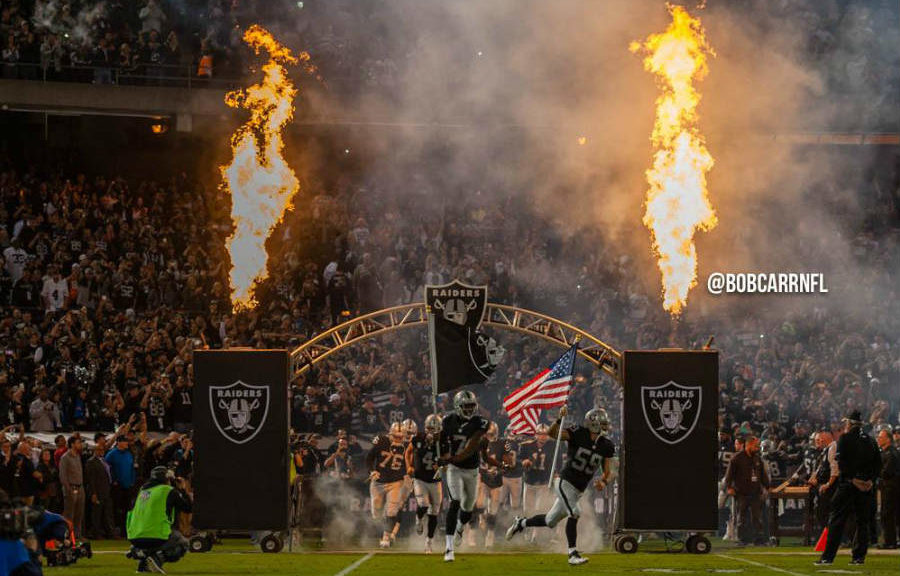
A footnote to history: Terrelle Pryor and the Supplemental Draft
These are strange times, in the Raider Nation and across the globe, as we grapple with the coronavirus, which has shut down professional sports — including spring football — and many other aspects of “normal” life.
So, even as we await a scaled-down 2020 NFL Draft in the Raiders’ new home of Las Vegas, it seems like as good a time as any to discuss one of the NFL’s stranger draft footnotes: the Supplemental Draft.
The annual Supplemental Draft is normally a summer footnote for those who follow (often marginal) college football prospects. This draft, held after the regular NFL Draft in April, is designed as an entry point into the league for players who have lost their eligibility to play NCAA football in the intervening time, often due to disciplinary issues.
A team can “bid” on a player in each round of the draft, forfeiting the equivalent pick in the following NFL Draft. So, for instance, if a team were to bid for a player in the fourth round, and win him, it would give up its fourth-round pick the next April. In many years, none of the eligible players is chosen, making them college free agents eligible to be signed by any team.
The Raiders have a very minimal history with the Supplemental Draft, having essentially chosen only one player since 1977, when most sources indicate the draft was formally initiated. (More on that in a minute.)
(Photo: The Raiders have not had much experience with the Supplemental Draft when it comes to team-building.)
The team’s lone selection in the traditional Supplemental Draft was a fairly recent one: quarterback Terrelle Pryor, chosen out of Ohio State with a third-round pick in 2011. Of course, the pick became known as the final choice made by owner Al Davis, who died during the 2011 season that fall.
Pryor, a three-year starter for the Buckeyes, had been suspended by the NCAA when it sanctioned the team in an improper benefits scandal that year. The loss of eligibility for what would have been his senior season led Pryor to enter the Supplemental Draft, and the Raiders took a chance on him there.
The Raiders forfeited their third-round pick in the 2012 NFL Draft as a result, and that, combined with then-coach Hue Jackson’s trade for quarterback Carson Palmer during the 2011 season, left the team’s first pick in 2012 as a late third-round compensatory selection.
Pryor was suspended by the NFL for the first five games of his rookie year as punishment for avoiding the NCAA suspension, and played in only one game that season — getting called for a false start penalty on a wildcat snap. He started the final game of the 2012 season, and then wound up starting nine games at quarterback in 2013. Pryor busted loose for a highlight-reel 93-yard touchdown run at one point, but injuries and ineffectiveness contributed to an overall mediocre season.
Pryor was traded to the Seattle Seahawks in the offseason for a seventh-round draft pick that became safety Jonathan Dowling. He bounced around for a few years, eventually converting to wide receiver, and most recently had a cup of coffee with the Jacksonville Jaguars during the 2019 training camp.
The selection of Pryor actually was not the first time the Raiders had participated in the Supplemental Draft, but the previous occasion was part of a special three-round draft of USFL and CFL players in 1984. That draft allowed NFL teams to claim the rights to players who had signed with the rival leagues, particularly the upstart USFL.
Selections in that draft included future stars such as quarterback Steve Young and defensive end Reggie White who had been lured to the USFL with big-money contracts.
The Raiders, of course, didn’t do things the usual way, choosing two players from the Canadian Football League and only one from the USFL.
The three were:
Wide receiver and kick returner Chris Woods of Auburn, who had signed with the Edmonton Eskimos; chosen with the 28th overall pick of the 1st round;
Linebacker Stewart Hill of Washington, who had also signed with the Eskimos; chosen with the 56th overall pick of the 2nd round;
Offensive guard James Farr of Clemson, who had signed with the Washington Federals; chosen with the 84th overall pick of the 3rd round.
Only Woods ever played for the Raiders, serving as the team’s primary punt returner in 1987 and spending part of 1988 on the roster as well.
Hill spent his career in the CFL, where he starred as a pass-rusher. Farr played two seasons in the USFL.
As mentioned, most sources cite 1977 as the year the NFL instituted the Supplemental Draft, but players were also chosen in 1973 and 1974, and one of them was chosen by the Raiders.
That was defensive end Blenda Gay, chosen in the first round in 1973 out of Fayetteville State. Gay, whose pick apparently came late enough that he wasn’t included in the team’s media guide, failed to make the team. Although Gay went on to an NFL career, he was killed by his wife in 1976 while still an active player, in a case involving allegations of abuse and insanity.
The Raiders have, from time to time, also signed players who were eligible for the Supplemental Draft, but not chosen. The most recent example was defensive back and special teams player Hiram Eugene, who signed in 2005 out of Louisiana Tech and played for Oakland until 2010.
(Editor’s Note: As we work to reboot and redesign the Raiders Research Project for 2020, early-year content may not reflect the final plans for the site in terms of both functionality and content. Please bear with us. ~ Ace)
Sources: Oakland Raiders media guides, Ourlads’ Scouting Services publications, NFL.com articles, Cleveland.com, The Football Database, CFLapedia, The Columbia County News-Times, Wikipedia
All photos (except as noted) by Bob Carr Photography; used with permission.